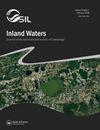Isolation and characterisation of monoclonal picocyanobacterial strains from contrasting New Zealand lakes
IF 2.3
3区 环境科学与生态学
Q1 LIMNOLOGY
引用次数: 2
Abstract
ABSTRACT Freshwater picocyanobacteria form the base of microbial food webs in many lakes worldwide but have received less attention than other phytoplankton. Little is known about their potential response to environmental changes such as increased nutrient loading and climate change, due partly to the lack of available cultured and sequenced strains. Here, we isolated 25 monoclonal picocyanobacterial strains from 6 New Zealand lakes with contrasting trophic states. The use of MLA medium instead of BG11 proved highly successful for the rapid isolation of picocyanobacteria. Strains were characterised by sequencing of the 16S ribosomal RNA gene, spectrophotometry, and high-performance liquid chromatography. 16S rRNA gene analysis placed most strains within the cluster 5 picocyanobacterial lineage (sub-cluster 5.2, family: Synechococcaceae). Phylogenetic analysis showed that 12 isolates from Lakes Wakatipu, Hayes, Johnson, and Ellesmere/Te Waihora clustered with strains from a range of Northern Hemisphere locations, suggesting global dispersal of these strains. Pigment characterisation revealed that pink and brown cultures from oligotrophic and some eutrophic lakes were rich in phycoerythrin, while green cultures from eutrophic and hypertrophic lakes were rich in phycocyanin. This diverse group of freshwater cluster 5 picocyanobacterial cultures will provide a new resource to study how these critically important microbes function and respond to changing environmental stressors.新西兰湖泊中微小蓝藻单克隆菌株的分离与鉴定
摘要淡水微微蓝藻是世界上许多湖泊微生物食物网的基础,但与其他浮游植物相比,它受到的关注较少。人们对它们对环境变化(如营养负荷增加和气候变化)的潜在反应知之甚少,部分原因是缺乏可用的培养和测序菌株。在这里,我们从新西兰6个湖泊中分离出25株具有不同营养状态的单克隆微微蓝藻菌株。使用MLA培养基代替BG11被证明在快速分离微微蓝藻方面非常成功。菌株通过16S核糖体RNA基因测序、分光光度法和高效液相色谱法进行鉴定。16S rRNA基因分析将大多数菌株置于聚类中 5微微蓝细菌谱系(亚簇 5.2,科:聚球藻科)。系统发育分析显示,来自Wakatipu湖、Hayes湖、Johnson湖和Ellesmere/Te Waihora湖的12个分离株与来自北半球一系列地区的菌株聚集在一起,表明这些菌株在全球传播。色素特性表明,来自贫营养化和一些富营养化湖泊的粉红色和棕色培养物富含藻红蛋白,而来自富营养化和肥大湖泊的绿色培养物富含藻类蓝蛋白。这个多样化的淡水集群 5微微蓝藻培养物将为研究这些至关重要的微生物如何发挥作用和应对不断变化的环境压力提供新的资源。
本文章由计算机程序翻译,如有差异,请以英文原文为准。
求助全文
约1分钟内获得全文
求助全文
来源期刊

Inland Waters
LIMNOLOGY-MARINE & FRESHWATER BIOLOGY
CiteScore
6.10
自引率
9.70%
发文量
34
审稿时长
>12 weeks
期刊介绍:
Inland Waters is the peer-reviewed, scholarly outlet for original papers that advance science within the framework of the International Society of Limnology (SIL). The journal promotes understanding of inland aquatic ecosystems and their management. Subject matter parallels the content of SIL Congresses, and submissions based on presentations are encouraged.
All aspects of physical, chemical, and biological limnology are appropriate, as are papers on applied and regional limnology. The journal also aims to publish articles resulting from plenary lectures presented at SIL Congresses and occasional synthesis articles, as well as issues dedicated to a particular theme, specific water body, or aquatic ecosystem in a geographical area. Publication in the journal is not restricted to SIL members.
 求助内容:
求助内容: 应助结果提醒方式:
应助结果提醒方式:


